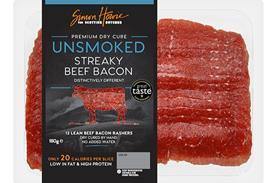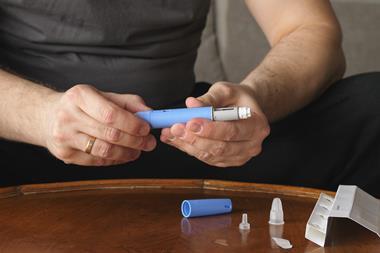Although the category is back in volume growth, marmalade and honey continue to struggle. Gordon Carson finds out what suppliers are doing to encourage more shoppers to the fixture
Paddington and Pooh will be scratching their heads over it they are bear-brained, after all but people seem to have fallen out of love with marmalade and honey.
Although value sales are up in both sub-categories, volume sales remain down. Meanwhile, spreads traditionally seen as less healthy, such as chocolate spreads and peanut butter, are enjoying strong value and volume growth as are other parts of the jams, spreads and honey category. Indeed, after a 2009 marked by sharp commodity-driven price rises and a commensurate slump in volume sales, the category is back in volume growth.
But why are the healthier options still in the doldrums? And what are manufacturers doing about it?
There's no doubt that although this year's price rises have not been as extreme, they continue to have an adverse impact, particularly on more premium sub-categories such as honey. UK honey prices increased by more than 10% last year, as bad weather affected harvests around the world, and currency movements honey is traded globally in US dollars put upward pressure on the cost of imports, which account for around 90% of the market.
On the plus side, volume sales were not down as much in 2010 as they were in 2009, when they slumped 5.4% probably because price rises were not as severe and were mitigated by promotional activity.
Kirstie Jamieson, marketing manager at Rowse Honey, says the challenge for the sector and her company, the leading brand in UK honey, is to attract "lapsed users" back to the product. "In any one year, 40% of UK households will buy honey, but this increases to 60% in every three-year period," she says. "That represents a 50% growth opportunity."
In a bid to persuade people to come back to honey, Rowse has redesigned its packaging and launched a range of 'Supahoney' products containing 50% Manuka that are more affordable than its other Manuka offerings.
Another brand hoping to inject some fresh interest into the sub-category is relatively new Anglo-Chilean entrant Healing Honey International, which was set up by former Halfords managing director Ian Staples and began selling its products in the UK via Duerr's in February 2010 under the brand name Active H2O2NEY.
Honey isn't the only sub-category that could arguably do with greater levels of innovation. Marmalade posted an identical fall in volume sales in 2010 as in 2009 (2.8%), despite heavy promotional activity from the likes of Rose's. Unfortunately, attempts to broaden its appeal appear to have had limited success, the sector's key demographic remaining the over-65s.
Jam has fared better, but it's not exactly in rude health. Volumes were only up marginally (0.3%), despite heavy advertising and promotional activity, a dearth of exciting NPD partly to blame.
Manufacturers have also been grappling with increasing input costs, which in many cases they have been forced to pass on to consumers. Streamline Foods, which makes reduced-sugar jams and marmalades, has raised prices by 8%, for instance, to reflect an increase in fruit costs caused by poor harvests and rising global demand.
The problem is that the sub-category is already high penetration and purchasing patterns are fairly predictable jam brands reckon the average consumer buys six jars a year so it's difficult to encourage consumers to buy more, let alone pay more.
That said, own-label sales continue to thrive across the board and the fastest-growing segment is the premium end (up 13.1% by value, against 8.3% for economy and 10.3% for standard lines, according to Kantar), which suggests that price does not necessarily trump all other factors especially when consumers can get their hands on a premium product for less than the cost of a branded equivalent.
Health continues to be another important consideration for consumers. Petty Wood, which distributes WeightWatchers jam under licence, reports growth from a 1.6% share of the reduced-sugar jam sector in 2009 to 12.7% [Kantar 52w/e 13 June 2010] helped by a combination of promotions and pushing the spread's health benefits. It is considering adding flavours in 2011.
As in other sub-categories, jam makers are also trying to broaden the appeal of their products. Andros-owned Bonne Maman, for instance, is launching its first cookbook this month. Others are refreshing their look. Streamline Foods plans to introduce new-look packs for its jams, supported by new messaging that will move the emphasis from a simple statement of reduced sugar content to a more comprehensive communication of their qualities: "more fruit, great taste, less sugar".
"'Reduced sugar' can be quite negative for some consumers," Streamline's managing director Martin Tilney explains, which is why the company is introducing a "more contemporary" jar this year, albeit one that will "almost certainly" remain a 454g size and will definitely be glass.
Although glass is overwhelmingly the category's packaging material of choice, plastic is making some inroads, particularly in the form of "squeezy" packs. Sales of Hartley's Squeezy Smooth jams, launched in March 2009, have reached £2m a year and the company introduced new raspberry and apricot flavours during 2010.
"Squeezy is bringing new users in. It's perfectly safe for children, and they also like smooth products," says Premier's Thomassen. "But there is resistance to change among older users, so we need time for this to filter through."
Getting more kids to eat jam is vital and Clippy's Apples co-founder Michelle McKenna would like to see British families emulate Scandinavian families, who eat three times as much jam as their UK counterparts.
Jam makers could do worse than take a leaf out of the chocolate spread makers' book. The perennial kids' favourite continues to go from strength to strength. Nutella has seen sales grow by a fifth in the last year, to £24.1m [Nielsen].
The Ferrero-owned brand says simplicity is key to its enduring success. "We have a very simple proposition for retailers and consumers one brand with three SKUs", says Jason Sutherland, sales director at Ferrero.
Nutella has also raised its game on the advertising front in a bid to encourage families to see it as a breakfast staple rather than an occasional treat. It continued with its Wake Up To Nutella campaign, devised to convince mothers of the health benefits of the spread and launched in 2007. A further £10m campaign is planned for 2011.
It's a different story in peanut butter. Although the sub-category is growing, much of the growth has been driven by own-label offerings, which now account for 54% of sales. Conversely, leading brand Sun-Pat has seen its value sales fall by 0.7%. In October, the Premier Foods brand unveiled a new-look jar, reduced packaging and introduced a new, nuttier flavour that it hopes will restore the brand to growth.
In terms of overall category growth, innovation is crucial and suppliers need look no further than yeast spread to see the impact it can have. Value sales are up 6.4% by value and 3.7% in volume, thanks chiefly to bold marketing activity from Marmite. The brand has made clever use of social media platforms, even launching its XO variant following input from its online superfans, 'The Marmarati'.
But perhaps the most important growth driver is retailer support. Although retailers are running more promotions, brands would like to see them devote more prominent in-store spaces to their products.
"We need to get out of our traditional merchandising area and on to gondola ends," says Rowse's Jamieson.
Nutella has already worked hard to win prime position on fixture, enabling the spread to attract new customers, and others will no doubt follow suit.
Many will also be looking to raise their games on the NPD, promotions and advertising fronts. They'll need to if they want to drive stronger volume growth and revive the fortunes of honey and marmalade.
Focus On Jams, Spreads & Honey
Paddington and Pooh will be scratching their heads over it they are bear-brained, after all but people seem to have fallen out of love with marmalade and honey.
Although value sales are up in both sub-categories, volume sales remain down. Meanwhile, spreads traditionally seen as less healthy, such as chocolate spreads and peanut butter, are enjoying strong value and volume growth as are other parts of the jams, spreads and honey category. Indeed, after a 2009 marked by sharp commodity-driven price rises and a commensurate slump in volume sales, the category is back in volume growth.
But why are the healthier options still in the doldrums? And what are manufacturers doing about it?
There's no doubt that although this year's price rises have not been as extreme, they continue to have an adverse impact, particularly on more premium sub-categories such as honey. UK honey prices increased by more than 10% last year, as bad weather affected harvests around the world, and currency movements honey is traded globally in US dollars put upward pressure on the cost of imports, which account for around 90% of the market.
On the plus side, volume sales were not down as much in 2010 as they were in 2009, when they slumped 5.4% probably because price rises were not as severe and were mitigated by promotional activity.
Kirstie Jamieson, marketing manager at Rowse Honey, says the challenge for the sector and her company, the leading brand in UK honey, is to attract "lapsed users" back to the product. "In any one year, 40% of UK households will buy honey, but this increases to 60% in every three-year period," she says. "That represents a 50% growth opportunity."
In a bid to persuade people to come back to honey, Rowse has redesigned its packaging and launched a range of 'Supahoney' products containing 50% Manuka that are more affordable than its other Manuka offerings.
Another brand hoping to inject some fresh interest into the sub-category is relatively new Anglo-Chilean entrant Healing Honey International, which was set up by former Halfords managing director Ian Staples and began selling its products in the UK via Duerr's in February 2010 under the brand name Active H2O2NEY.
Honey isn't the only sub-category that could arguably do with greater levels of innovation. Marmalade posted an identical fall in volume sales in 2010 as in 2009 (2.8%), despite heavy promotional activity from the likes of Rose's. Unfortunately, attempts to broaden its appeal appear to have had limited success, the sector's key demographic remaining the over-65s.
Jam has fared better, but it's not exactly in rude health. Volumes were only up marginally (0.3%), despite heavy advertising and promotional activity, a dearth of exciting NPD partly to blame.
Manufacturers have also been grappling with increasing input costs, which in many cases they have been forced to pass on to consumers. Streamline Foods, which makes reduced-sugar jams and marmalades, has raised prices by 8%, for instance, to reflect an increase in fruit costs caused by poor harvests and rising global demand.
The problem is that the sub-category is already high penetration and purchasing patterns are fairly predictable jam brands reckon the average consumer buys six jars a year so it's difficult to encourage consumers to buy more, let alone pay more.
That said, own-label sales continue to thrive across the board and the fastest-growing segment is the premium end (up 13.1% by value, against 8.3% for economy and 10.3% for standard lines, according to Kantar), which suggests that price does not necessarily trump all other factors especially when consumers can get their hands on a premium product for less than the cost of a branded equivalent.
Health continues to be another important consideration for consumers. Petty Wood, which distributes WeightWatchers jam under licence, reports growth from a 1.6% share of the reduced-sugar jam sector in 2009 to 12.7% [Kantar 52w/e 13 June 2010] helped by a combination of promotions and pushing the spread's health benefits. It is considering adding flavours in 2011.
As in other sub-categories, jam makers are also trying to broaden the appeal of their products. Andros-owned Bonne Maman, for instance, is launching its first cookbook this month. Others are refreshing their look. Streamline Foods plans to introduce new-look packs for its jams, supported by new messaging that will move the emphasis from a simple statement of reduced sugar content to a more comprehensive communication of their qualities: "more fruit, great taste, less sugar".
"'Reduced sugar' can be quite negative for some consumers," Streamline's managing director Martin Tilney explains, which is why the company is introducing a "more contemporary" jar this year, albeit one that will "almost certainly" remain a 454g size and will definitely be glass.
Although glass is overwhelmingly the category's packaging material of choice, plastic is making some inroads, particularly in the form of "squeezy" packs. Sales of Hartley's Squeezy Smooth jams, launched in March 2009, have reached £2m a year and the company introduced new raspberry and apricot flavours during 2010.
"Squeezy is bringing new users in. It's perfectly safe for children, and they also like smooth products," says Premier's Thomassen. "But there is resistance to change among older users, so we need time for this to filter through."
Getting more kids to eat jam is vital and Clippy's Apples co-founder Michelle McKenna would like to see British families emulate Scandinavian families, who eat three times as much jam as their UK counterparts.
Jam makers could do worse than take a leaf out of the chocolate spread makers' book. The perennial kids' favourite continues to go from strength to strength. Nutella has seen sales grow by a fifth in the last year, to £24.1m [Nielsen].
The Ferrero-owned brand says simplicity is key to its enduring success. "We have a very simple proposition for retailers and consumers one brand with three SKUs", says Jason Sutherland, sales director at Ferrero.
Nutella has also raised its game on the advertising front in a bid to encourage families to see it as a breakfast staple rather than an occasional treat. It continued with its Wake Up To Nutella campaign, devised to convince mothers of the health benefits of the spread and launched in 2007. A further £10m campaign is planned for 2011.
It's a different story in peanut butter. Although the sub-category is growing, much of the growth has been driven by own-label offerings, which now account for 54% of sales. Conversely, leading brand Sun-Pat has seen its value sales fall by 0.7%. In October, the Premier Foods brand unveiled a new-look jar, reduced packaging and introduced a new, nuttier flavour that it hopes will restore the brand to growth.
In terms of overall category growth, innovation is crucial and suppliers need look no further than yeast spread to see the impact it can have. Value sales are up 6.4% by value and 3.7% in volume, thanks chiefly to bold marketing activity from Marmite. The brand has made clever use of social media platforms, even launching its XO variant following input from its online superfans, 'The Marmarati'.
But perhaps the most important growth driver is retailer support. Although retailers are running more promotions, brands would like to see them devote more prominent in-store spaces to their products.
"We need to get out of our traditional merchandising area and on to gondola ends," says Rowse's Jamieson.
Nutella has already worked hard to win prime position on fixture, enabling the spread to attract new customers, and others will no doubt follow suit.
Many will also be looking to raise their games on the NPD, promotions and advertising fronts. They'll need to if they want to drive stronger volume growth and revive the fortunes of honey and marmalade.
Focus On Jams, Spreads & Honey

















No comments yet